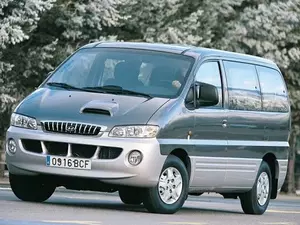
| Vehicle | Curb weight | Difference from world's smallest | Weight to power ratio | 0—60 mph acceleration ratio | Consumption ratio |
|---|---|---|---|---|---|
| 2.5 D |
2497 kg / 5506 lbs |
2072 kg (4569 lbs) heavier | 14 kg to 1 hp | - |
242 kg/L (534 lbs/L) |
| Vehicle | 2.5 D |
|---|---|
| Curb weight |
2497 kg / 5506 lbs |
| Difference from world's smallest | 2072 kg (2072 lbs) heavier |
| Weight to power ratio | 14 kg to 1 hp |
| 0—60 mph acceleration ratio | - |
| Consumption ratio |
242 kg/L (534 lbs/L) |

| Vehicle | Curb weight | Difference from world's smallest | Weight to power ratio | 0—60 mph acceleration ratio | Consumption ratio |
|---|---|---|---|---|---|
| 2.5 CRDi |
2260 kg / 4983 lbs |
1835 kg (4046 lbs) heavier | 19 kg to 1 hp | 108 kg/s (238 lbs/s) |
269 kg/L (593 lbs/L) |
| Vehicle | 2.5 CRDi |
|---|---|
| Curb weight |
2260 kg / 4983 lbs |
| Difference from world's smallest | 1835 kg (1835 lbs) heavier |
| Weight to power ratio | 19 kg to 1 hp |
| 0—60 mph acceleration ratio | 108 kg/s (238 lbs/s) |
| Consumption ratio |
269 kg/L (593 lbs/L) |

| Vehicle | Curb weight | Difference from world's smallest | Weight to power ratio | 0—60 mph acceleration ratio | Consumption ratio |
|---|---|---|---|---|---|
| 2.5 CRDi |
2059 kg / 4540 lbs |
1634 kg (3603 lbs) heavier | 12 kg to 1 hp | 148 kg/s (326 lbs/s) |
234 kg/L (516 lbs/L) |
| Vehicle | 2.5 CRDi |
|---|---|
| Curb weight |
2059 kg / 4540 lbs |
| Difference from world's smallest | 1634 kg (1634 lbs) heavier |
| Weight to power ratio | 12 kg to 1 hp |
| 0—60 mph acceleration ratio | 148 kg/s (326 lbs/s) |
| Consumption ratio |
234 kg/L (516 lbs/L) |

| Vehicle | Curb weight | Difference from world's smallest | Weight to power ratio | 0—60 mph acceleration ratio | Consumption ratio |
|---|---|---|---|---|---|
| 2.5 CRDi |
2079 kg / 4584 lbs |
1654 kg (3647 lbs) heavier | 18 kg to 1 hp | 99 kg/s (218 lbs/s) |
274 kg/L (604 lbs/L) |
| Vehicle | 2.5 CRDi |
|---|---|
| Curb weight |
2079 kg / 4584 lbs |
| Difference from world's smallest | 1654 kg (1654 lbs) heavier |
| Weight to power ratio | 18 kg to 1 hp |
| 0—60 mph acceleration ratio | 99 kg/s (218 lbs/s) |
| Consumption ratio |
274 kg/L (604 lbs/L) |

| Vehicle | Curb weight | Difference from world's smallest | Weight to power ratio | 0—60 mph acceleration ratio | Consumption ratio |
|---|---|---|---|---|---|
| 2.5 CRDi |
2175 kg / 4796 lbs |
1750 kg (3859 lbs) heavier | 19 kg to 1 hp | - |
290 kg/L (639 lbs/L) |
| Vehicle | 2.5 CRDi |
|---|---|
| Curb weight |
2175 kg / 4796 lbs |
| Difference from world's smallest | 1750 kg (1750 lbs) heavier |
| Weight to power ratio | 19 kg to 1 hp |
| 0—60 mph acceleration ratio | - |
| Consumption ratio |
290 kg/L (639 lbs/L) |

| Vehicle | Curb weight | Difference from world's smallest | Weight to power ratio | 0—60 mph acceleration ratio | Consumption ratio |
|---|---|---|---|---|---|
| 2.5 CRDI |
1910 kg / 4212 lbs |
1485 kg (3275 lbs) heavier | 14 kg to 1 hp | 157 kg/s (346 lbs/s) |
220 kg/L (485 lbs/L) |
| 2.5 TD |
1922 kg / 4238 lbs |
1497 kg (3301 lbs) heavier | 19 kg to 1 hp | - |
200 kg/L (441 lbs/L) |
| 2.4 |
1790 kg / 3947 lbs |
1365 kg (3010 lbs) heavier | 16 kg to 1 hp | 91 kg/s (201 lbs/s) | - |
| 2.4 i 16V 4WD SWB |
1790 kg / 3947 lbs |
1365 kg (3010 lbs) heavier | 13 kg to 1 hp | - | - |
| 2.4 i 4WD |
1950 kg / 4300 lbs |
1525 kg (3363 lbs) heavier | 18 kg to 1 hp | 92 kg/s (203 lbs/s) | - |
| 2.4 i 16V LWB |
1840 kg / 4057 lbs |
1415 kg (3120 lbs) heavier | 14 kg to 1 hp | - | - |
| 2.4 i LWD |
1815 kg / 4002 lbs |
1390 kg (3065 lbs) heavier | 17 kg to 1 hp | 93 kg/s (205 lbs/s) | - |
| 2.5 CRDI LWB |
1920 kg / 4234 lbs |
1495 kg (3297 lbs) heavier | 14 kg to 1 hp | 157 kg/s (346 lbs/s) |
221 kg/L (487 lbs/L) |
| 2.5 TD 4WD SWB |
1790 kg / 3947 lbs |
1365 kg (3010 lbs) heavier | 18 kg to 1 hp | - | - |
| 2.5 TD LWB |
1840 kg / 4057 lbs |
1415 kg (3120 lbs) heavier | 18 kg to 1 hp | - | - |
| Vehicle | 2.5 CRDI |
|---|---|
| Curb weight |
1910 kg / 4212 lbs |
| Difference from world's smallest | 1485 kg (1485 lbs) heavier |
| Weight to power ratio | 14 kg to 1 hp |
| 0—60 mph acceleration ratio | 157 kg/s (346 lbs/s) |
| Consumption ratio |
220 kg/L (485 lbs/L) |
| Vehicle | 2.5 TD |
| Curb weight |
1922 kg / 4238 lbs |
| Difference from world's smallest | 1497 kg (1497 lbs) heavier |
| Weight to power ratio | 19 kg to 1 hp |
| 0—60 mph acceleration ratio | - |
| Consumption ratio |
200 kg/L (441 lbs/L) |
| Vehicle | 2.4 |
| Curb weight |
1790 kg / 3947 lbs |
| Difference from world's smallest | 1365 kg (1365 lbs) heavier |
| Weight to power ratio | 16 kg to 1 hp |
| 0—60 mph acceleration ratio | 91 kg/s (201 lbs/s) |
| Consumption ratio | - |
| Vehicle | 2.4 i 16V 4WD SWB |
| Curb weight |
1790 kg / 3947 lbs |
| Difference from world's smallest | 1365 kg (1365 lbs) heavier |
| Weight to power ratio | 13 kg to 1 hp |
| 0—60 mph acceleration ratio | - |
| Consumption ratio | - |
| Vehicle | 2.4 i 4WD |
| Curb weight |
1950 kg / 4300 lbs |
| Difference from world's smallest | 1525 kg (1525 lbs) heavier |
| Weight to power ratio | 18 kg to 1 hp |
| 0—60 mph acceleration ratio | 92 kg/s (203 lbs/s) |
| Consumption ratio | - |
| Vehicle | 2.4 i 16V LWB |
| Curb weight |
1840 kg / 4057 lbs |
| Difference from world's smallest | 1415 kg (1415 lbs) heavier |
| Weight to power ratio | 14 kg to 1 hp |
| 0—60 mph acceleration ratio | - |
| Consumption ratio | - |
| Vehicle | 2.4 i LWD |
| Curb weight |
1815 kg / 4002 lbs |
| Difference from world's smallest | 1390 kg (1390 lbs) heavier |
| Weight to power ratio | 17 kg to 1 hp |
| 0—60 mph acceleration ratio | 93 kg/s (205 lbs/s) |
| Consumption ratio | - |
| Vehicle | 2.5 CRDI LWB |
| Curb weight |
1920 kg / 4234 lbs |
| Difference from world's smallest | 1495 kg (1495 lbs) heavier |
| Weight to power ratio | 14 kg to 1 hp |
| 0—60 mph acceleration ratio | 157 kg/s (346 lbs/s) |
| Consumption ratio |
221 kg/L (487 lbs/L) |
| Vehicle | 2.5 TD 4WD SWB |
| Curb weight |
1790 kg / 3947 lbs |
| Difference from world's smallest | 1365 kg (1365 lbs) heavier |
| Weight to power ratio | 18 kg to 1 hp |
| 0—60 mph acceleration ratio | - |
| Consumption ratio | - |
| Vehicle | 2.5 TD LWB |
| Curb weight |
1840 kg / 4057 lbs |
| Difference from world's smallest | 1415 kg (1415 lbs) heavier |
| Weight to power ratio | 18 kg to 1 hp |
| 0—60 mph acceleration ratio | - |
| Consumption ratio | - |